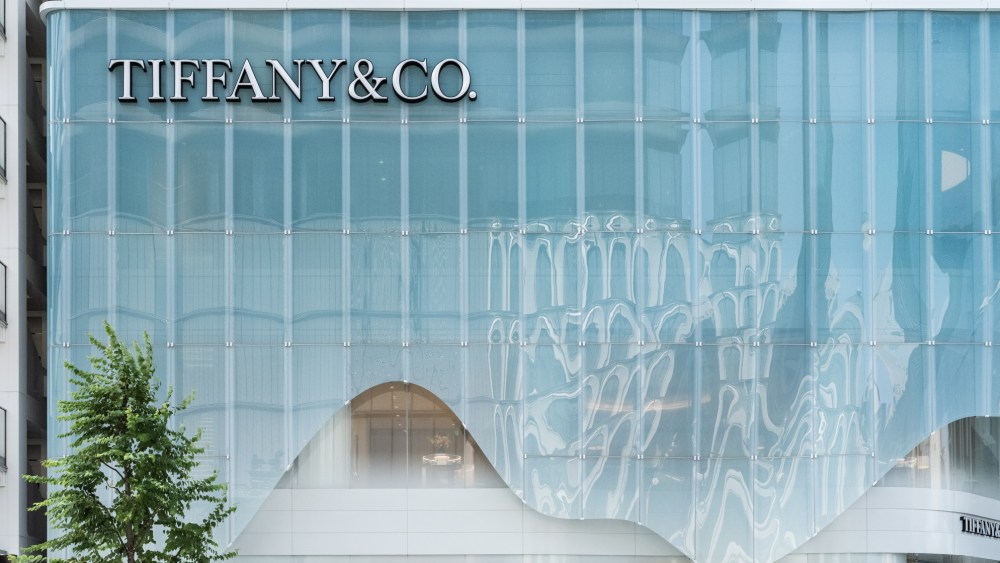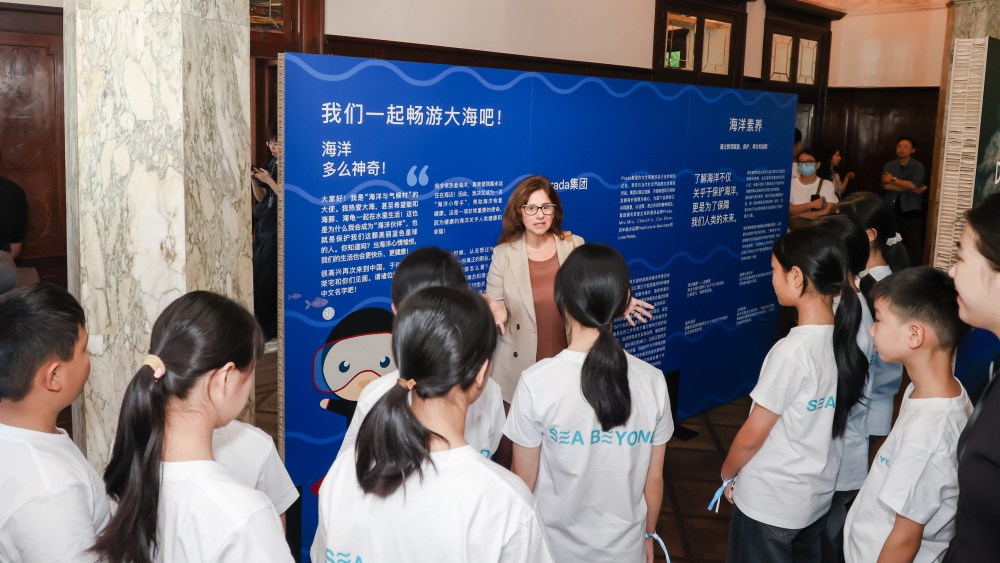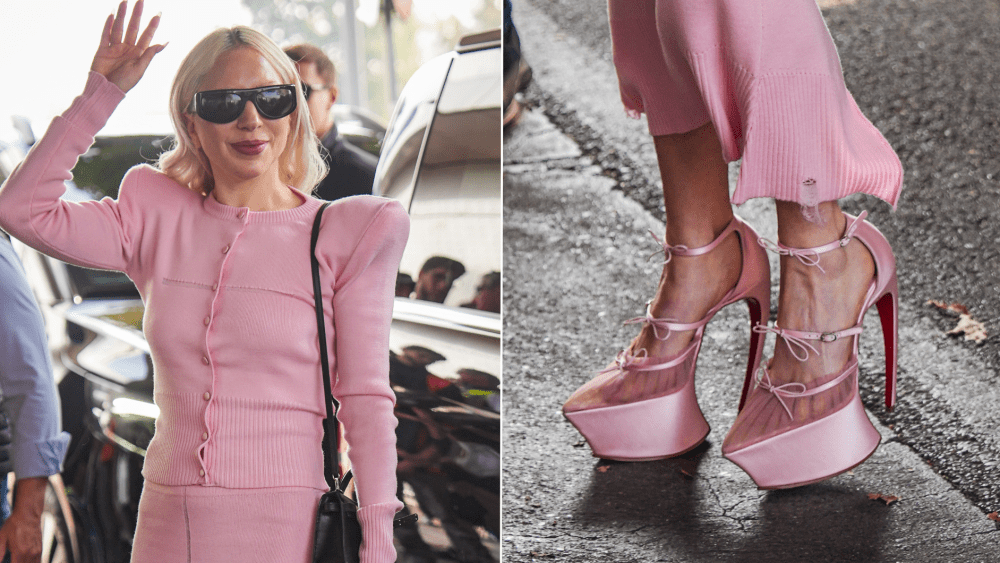
TOKYO — Tiffany & Co. is going big in Japan, as it opens its largest store in Asia on Friday. Located in the ritzy Ginza district of the Japanese capital, the boutique stands out with a massive, shining facade in the brand’s signature blue color.
Tiffany’s chief executive officer Anthony Ledru described the store as a “lighthouse” for the brand, similar to its iconic Fifth Avenue flagship in New York, called The Landmark, but with even more of a visual impact.
“It doesn’t happen very often, to be able to secure a brand new building in Ginza. Omotesando was another one, but that was an existing building. This one was everything from scratch, with the ability to really build the facade that we believe is one of the most, or the most, beautiful of all LVMH stores worldwide. I feel it’s a bit arrogant to say that, but it’s definitely in the top three,” Ledru said.

Inside the new Tiffany store.
“It’s 66 meters [high], it’s a facade taking you to heaven. All Tiffany blue, up to the sky. You don’t see the difference between the sky and Tiffany,” he added. “And it’s the first time since the [LVMH Moët Hennessy Louis Vuitton] acquisition that we’ve been able to create such a big impact from outside. Because even The Landmark, we only touched the top part of the building, but the facade was just cleaned up. If you don’t get inside, you don’t know that it’s been renovated.”
While Tiffany doesn’t own the Ginza building, it occupies six of its 12 floors, with store space starting from the basement and extending to the third floor, Japan’s first official Blue Box Café on the fourth floor, and an invitation-only VIP space on the 12th floor. Even so, the brand’s logo appears on the top of the building’s impactful blue exterior.
The store’s architecture was designed by Jun Aoki, with interiors by Peter Marino. The project has been in the works for four years, with construction lasting almost exactly two years.
“There has been a sense of readiness to open a ‘lighthouse’ like this in Japan,” Ledru said. “It’s something that has not been done yet in Tokyo.”

Exterior of the Tiffany Store in Tokyo
Kohey Kanno/WWD
An Impactful Facade
To design the store’s roughly 80,730-square-foot facade, Aoki said that he was inspired by stained glass pieces that he found in Tiffany’s archives, particularly one featuring wisteria flowers.
“There is no nature in Ginza, it’s all just buildings,” Aoki said. “So I wanted to add something that invokes nature, rather than something that is just another man-made object.”
He said the shape of the curved glass is reminiscent of wisteria hanging from above and swaying in the wind. To create the signature color on the outside without casting a blue hue inside the store, he covered the glass in tiny white dots, before layering blue dots over them.
The Ginza store spans over 27,340 square feet, with several design elements that celebrate the brand’s long history and close ties to Japan, where it opened its first store over 50 years ago, in 1972. In addition to artworks by Michelangelo Pistoletto, Damien Hirst, Julian Schnabel, Donald Judd and more, the space incorporates the works of over 100 Japanese artisans.
There are washi paper-covered ceilings that resemble origami, other ceilings covered in gold leaf from the Japanese city of Kanazawa, furniture upholstered in exquisite fabrics by Hosoo, window displays by the Japanese artist Kimiko Fujimura, and another window designed by Mariko Kusumoto and inspired by the Japanese theatrical art form Kabuki.

An interior view of the new Tiffany store.
Kohey Kanno/WWD
A sweeping staircase that leads visitors between the floors features walls of digital screens depicting scenes inspired by the Ninomaru Garden of Tokyo’s Imperial Palace. The artwork, titled “Immersive Moving Fresco” by Oyoram Visual Composer, incorporates jewel-encrusted birds that flitter among the flowers and trees as customers pass by.
“We are offering something that embraces Japanese culture and the love story that we have with Japan,” Ledru said.
A Special Café
The Blue Box Café on the fourth floor showcases Tiffany’s home collection and boasts a dedicated terrace, a rarity in Ginza. The café’s menu was developed by renowned chef Natsuko Shoji, who has been lauded as Asia’s best female chef and Asia’s best pastry chef. In addition to her highly sought-after cakes, diners will be able to enjoy full meals in the space, which is decorated with flower installations by Makoto Azuma.

A view of the Blue Box Café.
Kohey Kanno/WWD
Ledru said that Tiffany does not plan to do another opening quite like this anywhere in the world for a while. There are major stores planned for the South Coast Plaza in California for next year, in Seoul for 2027, and Paris, Osaka, and Rodeo Driver for 2028, but none of them will have the kind of facade that the Ginza store has.
The Tiffany Ginza store represents Aoki’s largest retail project to date, although he has designed several stores for Louis Vuitton around the world, as well as a Loro Piana store, also in Ginza. Both brands are also owned by LVMH.
“It’s very difficult to do a store this large,” the architect said. “I am used to working with craftspeople on retail projects, but for something like this, it can’t be artisan-made, it has to be on an industrial scale. So the challenge is to make something that is industrial but looks artisan-made.”
The glass that covers three sides of the corner building features two-dimensional curves for a fluid look, while the corners incorporate three-dimensional curves. Aoki said that this technique is something that the average person would not notice, but they would see a natural softness without understanding the technical reason behind it. He said that he was inspired by the softness he saw in Marino’s interiors of The Landmark when he visited New York.
“The Landmark opening in 2023 marked the beginning of a new era for us, and we are working on about 40 projects a year, which is high for the industry,” Ledru said. He added that Tiffany has already renovated roughly half of its 60 stores in Japan to be in line with its latest design concept.
Japan is an extremely important market for Tiffany, representing both the first Asian market that it entered and accounting for more sales than any other country aside from the United States. It is because of this that the company decided to make one of its largest investments ever into the Ginza store. While traditionally the brand was seen as a leader in bridal and solitaires in Japan, this has expanded in recent years to include other iconic Tiffany collections.

The home collection on display.
Kohey Kanno/WWD
“It’s the number-two market and it’s been growing by double digits over the last four years. This year we are positive, because we are so focused on local business and local clientele. We perhaps missed out a little bit on the tourists last year, which other brands benefited from, but we wanted the team to really focus on building the local clientele, and that business is constantly in growth over the last four years,” said Gavin Haig, Tiffany’s executive vice president and chief commercial officer. “And I think that the opportunity upside that we have now as we expand into all these moments of love that we shared about, we’re only touching the surface, to be honest. So we’re very confident, hence the level of investment.”
Both Ledru and Haig agreed that, while the Ginza store will continue to be Japan’s largest Tiffany outlet, the brand is not done growing here. Haig also said that the average sale among Japanese consumers has doubled over the past three years, signaling that there is even more to come for Tiffany in its most significant international market.

A display in the store.
Kohey Kanno/WWD
#Tiffany #Unveils #Tokyo #Store #Biggest #Asia








